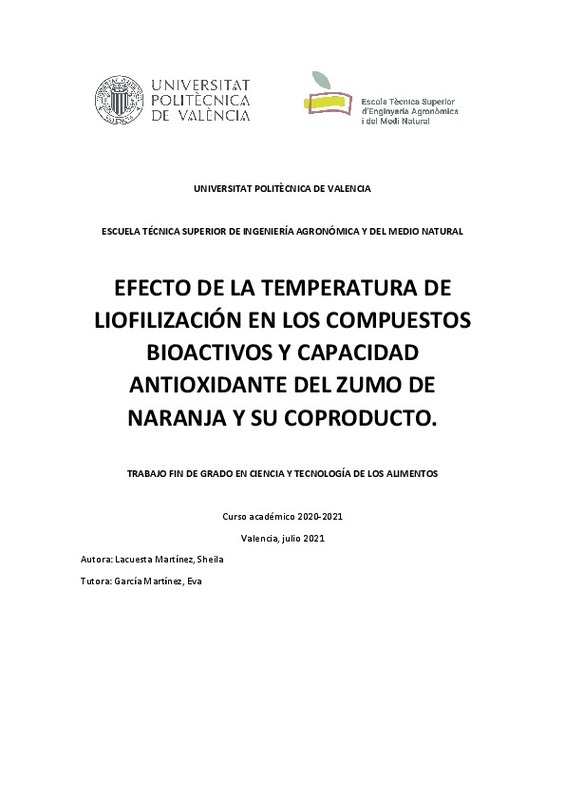|
Resumen:
|
[ES] En el proceso de obtención de zumo de naranja se genera un gran volumen de residuos que tienen un contenido abundante en compuestos fitoquímicos con propiedades antioxidantes. Su preciada composición justificaría el ...[+]
[ES] En el proceso de obtención de zumo de naranja se genera un gran volumen de residuos que tienen un contenido abundante en compuestos fitoquímicos con propiedades antioxidantes. Su preciada composición justificaría el interés en su reintroducción en la cadena alimentaria humana para la producción de alimentos funcionales, lo que mejoraría la eficiencia de este tipo de industrias fomentando una economía circular al convertir los residuos en recursos. En este sentido, hay que tener en cuenta que las frutas y también los coproductos provenientes de la industria de su transformación presentan un elevado contenido en agua que los hace altamente perecederos, por lo que se hace necesario algún tipo de procesado que permita su estabilización con técnicas que minimicen la pérdida de compuestos nutritivos y bioactivos. En este trabajo se utilizará la técnica de liofilización para la deshidratación de zumo de naranja y su coproducto para la obtención de productos de alta calidad que podrían ser utilizados como extractos de compuestos bioactivos y/o como ingredientes. Además, se variará la temperatura de bandeja del liofilizador (30ºC y 50ºC), para estudiar la influencia del proceso, y se incorporarán biopolímeros naturales (goma arábiga y fibra de bambú) como posibles estabilizadores físicos y químicos. Para el estudio, se analizará, antes y después de la liofilización, el contenido en la vitamina C, el ácido L-ascórbico, ácido dehidroascórbico, carotenoides (licopeno y beta caroteno) y compuestos fenólicos totales. También se analizará la actividad antioxidante y se estudiará su bioaccesibilidad tras la digestión in vitro de las muestras.
[-]
[EN] In the process of obtaining orange juice, a large volume of waste is generated, and it has an abundant content of phytochemical compound with antioxidant properties. That composition would justify the interest in its ...[+]
[EN] In the process of obtaining orange juice, a large volume of waste is generated, and it has an abundant content of phytochemical compound with antioxidant properties. That composition would justify the interest in its reintroduction into the human food chain for the production of functional foods, which would improve the efficiency of this type of industries by promoting circular economy, converting waste into resources. In this matter, it must be taken into account that the fruits and also the co-products from de processing industry have a high-water content that makes them highly perishable, so some type of processing is necessary that allows their stabilization with techniques that minimize the loss of nutritive bioactive compounds. In this study, the lyophilization technique was used to dehydrate orange juice and its co-product to obtain high-quality products that could be used as extracts of bioactive compounds and/or as ingredients. In addition, the freeze-dryer tray temperature was varied (30ºC and 50ºC), to study the influence of the process, and natural biopolymers (gum Arabic and bamboo fibre) were incorporated as possible physical and chemical stabilizers. For the study, the content of vitamin C, L-ascorbic acid, dehydroascorbic acid, carotenoids (ß-carotene) and total phenolic compounds were analysed before and after lyophilization. The antioxidant activity was also analysed and its bioaccessibility was studied after the in vitro digestions of the samples. After carrying out the analyses, a there was higher quantity of bioactive compounds in the co-product compared to that of the juice, presenting a higher antioxidant activity. Lyophilization of the samples at 30ºC maintained more effectively the number of bioactive compounds, compared to lyophilization at 50ºC. The addition of biopolymers had no effect on this preservation of bioactive compounds. Finally, after in vitro digestions, the bioaccessibility of the bioactive compounds was very low, especially in the lyophilized samples, because they are compounds sensitive to light, pH, temperature and the presence of digestive enzymes. Therefore, the co-product of orang juice lyophilized at 30ºC, without the need for the addition of biopolymers, is a good option as a possible ingredient rich in bioactive compounds for food use.
[-]
|







